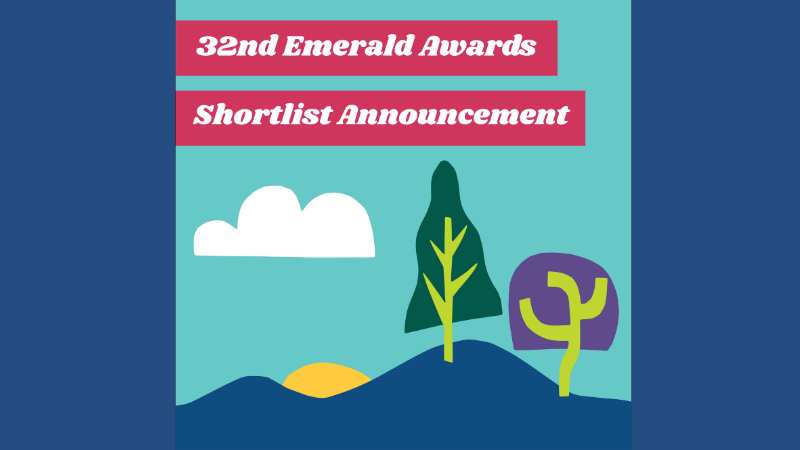Alberta
Alberta’s environmental leaders recognized

The Alberta Emerald Foundation (AEF) announced the shortlist for the 32nd Annual Emerald Awards this week. Since 1992, the Emerald Awards have showcased over 350 recipients and 850 finalists who are raising the bar in addressing environmental and climate change issues. These environmental awards celebrate excellence across all sectors, making them unique not only in Alberta but also in Canada.
This year’s shortlist was chosen by a third-party panel of volunteer judges, each bringing expertise from numerous sectors across Alberta. Judges selected the shortlist, consisting of 39 organizations, projects, and individuals from across the province, from 51 nominations. During their deliberations, the judges also determined who from the shortlist will take home an Emerald Award in each of the 15 award categories.
“Those represented in this year’s shortlist demonstrate the incredible dedication that Albertans have toward protecting our environment and taking action against climate change” says The AEF’s Executive Director, Marisa Orfei, “The diversity in the shortlist is also astounding, there’s small grassroots organizations, large corporations, and everything in between. We’re also incredibly proud to have 17 communities across Alberta represented in this year’s shortlist, including Drayton Valley, Grande Cache, Canmore, and many more.”
Here are the organizations, projects, and individuals recognized in The 32nd Annual Emerald Award shortlist:
Air Category – Recognizing projects and initiatives that improve air quality.
- Blindman Brewing First-in-Canada CO2 Capture and Utilization (Lacombe, AB)
Business Category – Showcasing an organization engaged in commercial, industrial or professional activities that have demonstrated a meaningful commitment to an environmentally sustainable future.
- Reimagine Architects – 26 Years Building Sustainable Futures (Edmonton, AB)
- Eco-Flex Recycled Rubber Solutions (Legal, AB)
- Envirotech Geothermal – Alberta’s smartest way to Net Zero! (Sherwood Park, AB)
Community Group or Nonprofit Category – Recognizing associations dedicated to furthering a particular social cause or advocating for a shared point of view that has demonstrated a significant commitment to the environment through their actions.
- Alberta Bike Swap – supporting the circular economy before it was cool (Calgary, AB)
- Project Forest: Rewilding Canada, One Forest at a time (Edmonton, AB)
- Alberta businesses are building a better Business-as-usual with Green Economy Canada (Edmonton, AB & Calgary, AB)
Education Category – Acknowledging those that have raised the bar by showing leadership and creativity in educating students of all ages about environmental matters.
- Eagle Point-Blue Rapids Parks Council Environmental & Outdoor Education Program (Drayton Valley, AB)
- Future Energy Systems: Exploring Our Energy Future With The Community, Our Students, And More (Edmonton, AB)
- Evergreen Theatre: A 32-Year Legacy of Inspiring Environmental Awareness & Action Through the Arts (Calgary, AB)
Energy Category – Recognizing projects and initiatives that positively support the evolution of our province’s energy systems.
- Calgary’s Residential Solar Calculator (Calgary, AB)
- Bow Valley Green Energy Cooperative, empowering community to transform Alberta’s energy (Canmore, AB)
- Metis Nation of Alberta Climate Change Action Plan (Edmonton, AB)
Government Category – Recognizing all levels of government whose ongoing commitment sets the example of environmental leadership and advocates sustainability as a major consideration in governance.
- Environmental Achievements of the City of St. Albert (St. Albert, AB)
- Violet Grove’s Constructed Floating Wetlands System with Aeration (Drayton Valley, AB)
- Nose Creek Watershed Partnership – Celebrating 25-Years of Watershed Planning, Policy and Action (Mossleigh, AB)
Infrastructure Category – Recognizing environmental advancements in the ways we design, build, and travel.
- Solar Aquatic Systems Wastewater Treatment (Drayton Valley, AB)
- SSRIA: Transforming the AEC Industry Towards a Net Zero Built Environment (Edmonton, AB)
- Ecoplast Solutions: Building Houses from Recycled Plastic Bottles (Lloydminster, AB)
Land Category – Recognizing projects and initiatives that demonstrate excellence in sustainable land use.
- The City of Calgary’s Willow Plantation for Marginal Land Improvement and Carbon Capture (Calgary, AB)
- Ledcor Highway Maintenance Yard Upgrades (Edmonton, AB)
Lifetime Achievement Award – Celebrating environmental leaders who, throughout their lifetime, have made contributions of outstanding environmental significance.
- Dirk and Nanja of The Barrelman Inc.: 25 years of protecting land and water through local action that inspires (Calgary, AB)
Public Engagement & Outreach Category – Recognizing programs and initiatives that educate and empower the broader public by teaching the necessary skills to make informed environmental decisions and take responsible action.
- GreenLearning’s Eco 360 program: Transitioning to a circular economy for plastic waste! (Drayton Valley, AB)
- My Green Closet: Sustainable Lifestyle and Slow Fashion Platform (Edmonton, AB)
- Calgary Climate Symposium: How The City of Calgary Engages and Educates Albertans on Climate Change (Calgary, AB)
Shared Footprints Award – Recognizing those who have exemplified land and water stewardship, built shared knowledge, improved air quality, reduced land disturbances, and encouraged ecotourism.
- Edmonton River Valley Conservation Coalition: Working Together to Protect the North Saskatchewan River Valley (Edmonton, AB)
- Highfield Regenerative Farm (Calgary, AB) Waste Management Category – Recognizing projects and initiatives that innovate the repurposing, reduction, and disposal of waste in an environmentally-conscious way. Earth Warrior (Edmonton, AB)
- Revolutionizing Recycling with [Re] Waste: Transforming Waste Management for a Sustainable Future (Edmonton, AB)
- Microgreens Club – A Zero Waste Initiative (Calgary, AB)
Water Category – Recognizing projects and initiatives that demonstrate excellence through the monitoring, management and/or stewardship of water and watersheds.
- Forest industry collaboration cultivates sustainability around vital wetland ecosystems (Edmonton, AB)
- LakeKeepers: Community-Based Monitoring of Alberta’s Lakes (Edmonton, AB)
- Safe water and water sustainability in Alberta (Calgary, AB)
Wildlife & Biodiversity Category – Recognizing projects and initiatives that protect and conserve natural habitats and wild species.
- Aseniwuche Winewak Nation’s Caribou Patrol Program: 11 years of saving Alberta’s caribou (Grande Cache, AB)
- Friends of Fish Creek Provincial Park Society – Sikome Beaver Coexistence Project. (Calgary, AB)
- The Edmonton Urban Coyote Project: Collaborative Research and Education for Coexistence with Wildlife (Edmonton, AB)
Youth Category – Recognizing people, 25 years of age and under, who have made meaningful contributions and have taken positive action to improve the environmental health of their community.
- Monica Figueroa: Edmonton youth climate activist (Edmonton, AB)
- Strathmore High School Community Greenhouse (Strathmore, AB)
- Energy & Environmental Sustainability Projects in Action at New Myrnam School (Myrnam, AB)
The recipients in each category will be named at the 32nd Annual Emerald Awards ceremony on June 7, 2023, at the Citadel Theatre in Edmonton, Alberta. Emerald Award Recipients receive:
- A $2,000 grant to support their work or to donate to an environmental charity of their choice
- A profile of their work through The AEF’s Sharing Stories program, which includes the Emerald Documentary Series, What On EARTH Can We Do? podcast, and Emerald Speakers Series
- A certificate and Emerald Awards recipient digital logo to commemorate their achievement
The Awards will also be live-streamed through the AEF”s YouTube Chanel to allow people from across the province to attend. Tickets for the 32nd Annual Emerald Awards ceremony can be purchased here.
The Alberta Emerald Foundation (AEF) is a registered Canadian charity with the unique mission to tell Alberta’s environmental good news stories to uplift, educate, and inspire our province toward meeting environmental and climate change goals.
Research suggests that when we learn about what real environmental and climate change solutions look like and how they’re being implemented in our communities, it increases our ability and desire to take action in our own lives. By providing real-life examples of these solutions through our various storytelling programs, the AEF helps Albertans take the next step toward environmental protection and climate action. With every person that we reach through our programming, we’re helping Alberta reach its broader environmental and climate change goals.
Click to learn more about the Alberta Emerald Foundation.
Alberta
Alberta takes big step towards shorter wait times and higher quality health care

From the Fraser Institute
On Monday, the Smith government announced that beginning next year it will change the way it funds surgeries in Alberta. This is a big step towards unlocking the ability of Alberta’s health-care system to provide more, better and faster services for the same or possibly fewer dollars.
To understand the significance of this change, you must understand the consequences of the current (and outdated) approach.
Currently, the Alberta government pays a lump sum of money to hospitals each year. Consequently, hospitals perceive patients as a drain on their budgets. From the hospital’s perspective, there’s little financial incentive to serve more patients, operate more efficiently and provide superior quality services.
Consider what would happen if your local grocery store received a giant bag of money each year to feed people. The number of items would quickly decline to whatever was most convenient for the store to provide. (Have a favourite cereal? Too bad.) Store hours would become less convenient for customers, alongside a general decline in overall service. This type of grocery store, like an Alberta hospital, is actually financially better off (that is, it saves money) if you go elsewhere.
The Smith government plans to flip this entire system on its head, to the benefit of patients and taxpayers. Instead of handing out bags of money each year to providers, the new system—known as “activity-based funding”—will pay health-care providers for each patient they treat, based on the patient’s particular condition and important factors that may add complexity or cost to their care.
This turns patients from a drain on budgets into a source of additional revenue. The result, as has been demonstrated in other universal health-care systems worldwide, is more services delivered using existing health-care infrastructure, lower wait times, improved quality of care, improved access to medical technologies, and less waste.
In other words, Albertans will receive far better value from their health-care system, which is currently among the most expensive in the world. And relief can’t come soon enough—for example, last year in Alberta the median wait time for orthopedic surgeries including hip and knee replacements was 66.8 weeks.
The naysayers argue this approach will undermine the province’s universal system and hurt patients. But by allowing a spectrum of providers to compete for the delivery of quality care, Alberta will follow the lead of other more successful universal health-care systems in countries such as Australia, Germany, the Netherlands and Switzerland and create greater accountability for hospitals and other health-care providers. Taxpayers will get a much better picture of what they’re paying for and how much they pay.
Again, Alberta is not exploring an untested policy. Almost every other developed country with universal health care uses some form of “activity-based funding” for hospital and surgical care. And remember, we already spend more on health care than our counterparts in nearly all of these countries yet endure longer wait times and poorer access to services generally, in part because of how we pay for surgical care.
While the devil is always in the details, and while it’s still possible for the Alberta government to get this wrong, Monday’s announcement is a big step in the right direction. A funding model that puts patients first will get Albertans more of the high-quality health care they already pay for in a timelier fashion. And provide to other provinces an example of bold health-care reform.
Alberta
Alberta’s embrace of activity-based funding is great news for patients

 From the Montreal Economic Institute
From the Montreal Economic Institute
Alberta’s move to fund acute care services through activity-based funding follows best practices internationally, points out an MEI researcher following an announcement made by Premier Danielle Smith earlier today.
“For too long, the way hospitals were funded in Alberta incentivized treating fewer patients, contributing to our long wait times,” explains Krystle Wittevrongel, director of research at the MEI. “International experience has shown that, with the proper funding models in place, health systems become more efficient to the benefit of patients.”
Currently, Alberta’s hospitals are financed under a system called “global budgeting.” This involves allocating a pre-set amount of funding to pay for a specific number of services based on previous years’ budgets.
Under the government’s newly proposed funding system, hospitals receive a fixed payment for each treatment delivered.
An Economic Note published by the MEI last year showed that Quebec’s gradual adoption of activity-based funding led to higher productivity and lower costs in the province’s health system.
Notably, the province observed that the per-procedure cost of MRIs fell by four per cent as the number of procedures performed increased by 22 per cent.
In the radiology and oncology sector, it observed productivity increases of 26 per cent while procedure costs decreased by seven per cent.
“Being able to perform more surgeries, at lower costs, and within shorter timelines is exactly what Alberta’s patients need, and Premier Smith understands that,” continued Mrs. Wittevrongel. “Today’s announcement is a good first step, and we look forward to seeing a successful roll-out once appropriate funding levels per procedure are set.”
The governments expects to roll-out this new funding model for select procedures starting in 2026.
* * *
The MEI is an independent public policy think tank with offices in Montreal, Ottawa, and Calgary. Through its publications, media appearances, and advisory services to policymakers, the MEI stimulates public policy debate and reforms based on sound economics and entrepreneurship.
-

 2025 Federal Election23 hours ago
2025 Federal Election23 hours agoRCMP memo warns of Chinese interference on Canadian university campuses to affect election
-

 2025 Federal Election2 days ago
2025 Federal Election2 days agoConservative Party urges investigation into Carney plan to spend $1 billion on heat pumps
-

 Alberta1 day ago
Alberta1 day agoAlberta takes big step towards shorter wait times and higher quality health care
-

 2025 Federal Election2 days ago
2025 Federal Election2 days agoFifty Shades of Mark Carney
-

 2025 Federal Election2 days ago
2025 Federal Election2 days agoCorporate Media Isn’t Reporting on Foreign Interference—It’s Covering for It
-

 2025 Federal Election13 hours ago
2025 Federal Election13 hours agoResearchers Link China’s Intelligence and Elite Influence Arms to B.C. Government, Liberal Party, and Trudeau-Appointed Senator
-

 Business1 day ago
Business1 day agoTrump raises China tariffs to 125%, announces 90-day pause for countries who’ve reached out to negotiate
-

 2025 Federal Election23 hours ago
2025 Federal Election23 hours agoThe status quo in Canadian politics isn’t sustainable for national unity






